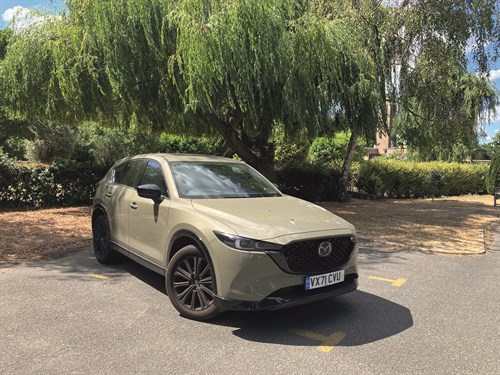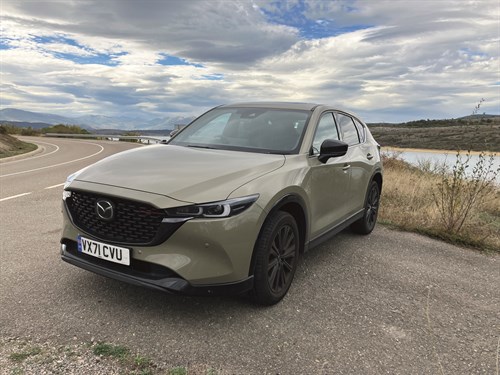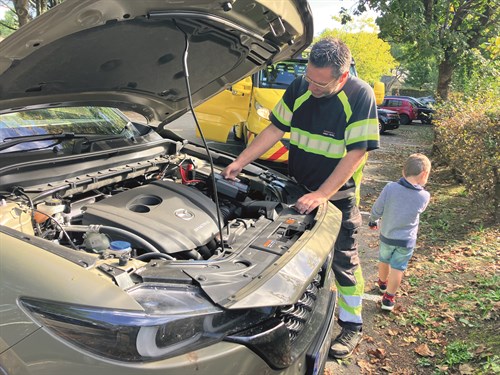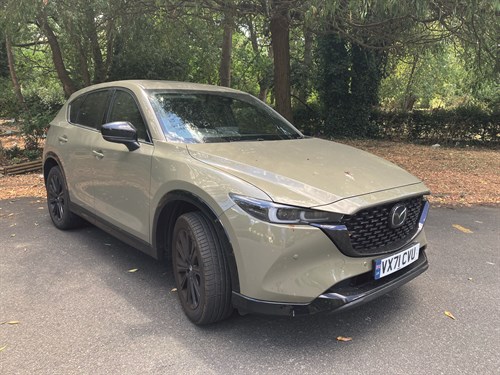We use cookies to ensure that we give you the best experience on our website. If you continue without changing your settings, we will assume that you are happy to receive all cookies on the Business Car website. However, if you would like to, you can change your cookies at any time

The start point for the best source of fleet information |
Final report: Mazda CX-5 long-term test
Date: 10 January 2023 | Author: Pete Tullin

|
|
||||||||||||
Final Report: Jack-of-all-trades
It has always struck me as rather odd that people are quick to undermine Jack's many talents by adding the old 'master of none' caveat.
With this in mind, I feel it only fair to say that when I refer to our departing Mazda CX-5 long-termer as a 'Jack-of-all-trades' I'm in no way damning it with faint praise.
Sure, increasingly punitive CO2 company car taxation bands haven't done the CX any favours. Cruelly exposing the Skyactive petrol engine's lack of electric assistance, meaning it qualifies for a top whack 35% BIK clobbering. Equally, as I've mentioned in earlier reports, the engine itself isn't particularly blessed when it comes to the giddy-up stakes and even when pushed to the point where it feels like it's about to implode, it's a conservative performer at best. These detractors and perhaps a questionable colour scheme apart, however, I've found the CX extremely difficult to fault.
After the fat end of 12,000 miles it remains as tight and rattle-free as the day it arrived and given it has been subjected to some pretty heavy lifting, including countless trips to various builders merchants and DIY stores, the interior panels have resisted knocks and scuffs extremely well. As a consequence, it requires little more than a bit of spit and polish to return things to pristine condition.
Interior space proved to be more than plentiful and the boot a useful size, too. It was also easily accessed thanks to the powered tailgate, which opened and closed via the key fob and if ever I needed any additional load-lugging capacity a couple of conveniently placed release levers located on each side of the boot ensured a quick release of the seat backs and a totally flat elongated load bay.

Just recently, Jack's namesake, Mr Frosty, decided to put in an unwelcome appearance and I found myself increasingly appreciative of the Mazda's heated seats and steering wheel, although if I'm being hypercritical, it would have been nice if Mazda had extended the hand wheel's elements throughout 360°, rather than limiting the voltage to the three and nine o'clock areas.
I also found it a bit frustrating that with the declining temperatures I had to manually clear the dewy overnight opaqueness of the side windows by using a squeegee each morning. Of course, you may think, a quick up and down would have been sufficient to clarify matters but because the CX's rubber seals don't come anywhere close to contacting the glass, this strategy leaves the side glass staunchly unimpressed. On a more positive note, I suppose because the seals aren't subjected to any abrasive interactions this will bode well for the longevity of their soundproofing integrity.
As well as a many short commutes I've undertaken my fair share of long-distance jaunts over the last few months so I can say with some authority that the Mazda's seats are exceptionally supportive and because the pedal box is perfectly laid out and bang in line with the steering wheel and the central console is heavily padded, back pain and knee cap abrasions were notable by their absence.
I also developed the ability to use the infotainment rotary command control and the shortcut buttons so intuitively I swear I could have operated them blind folded and because this layout eliminates the need for a touch screen, switching between Apps and navigation inputs remained mercifully free of the usual hit and miss antics that plague so many inferior rivals' systems.
Although I'm not about to suggest the CX is some kind of dynamic marvel it is one of the neatest handling cars in its sector. Yes, it is still a high-riding SUV, so following a competent estate car, such as a Skoda Octavia down a fast, open road, it would be left to eat dust but the Mazda has talents in different areas. These talents include the commanding driving position and swivelling front wheel chasing headlights, which along with the auto high beam function, always gave me a sporting chance of spotting falling branches and the increasing number of curbside potholes that coincided with some time stealing bandit plunging my morning and evening commutes into wintry darkness.
In addition to this visibility boost, a subtle ride quality and an overall dynamic poise, combined with the type of steering accuracy than eludes many of its rivals, ensured the CX remained a reassuringly predictable car and one ideally suited to negotiating soaking wet, leaf-strewn B-roads.
Jack of all trades and master of none? More like 'master of most'.
5th Report: Finding technology
Compared with many similarly sized SUVs, our Mazda CX-5 is a breezy featherweight and as any engineer will tell you less is certainly more when it comes to controlling body movements, enhancing ride comfort, reducing fuel consumption, and boosting performance. Consequently, the CX is one of the more comfortable and agile cars in the sector. Performance wise? Not so much.
Perhaps unsurprisingly, the main culprit lies under the bonnet, as the CX still relies on a traditional style 2.0-litre petrol engine, which, despite Mazda's latest high compression combustion developments, fails to deliver the easy drivability of a similar capacity turbocharged engine.
Consequently, any inherent weight savings are undermined by low-end power deficiencies and the consequences this has on day-to-day performance are often quite stark. Most notably when it comes to weighing up overtaking manoeuvres.
I find the best, if not the subtlest approach, is to chop down a couple of ratios before stamping on the accelerator with what can only be described as sadistic intent. Even then, employing this brutal lack of mechanical sympathy doesn't exactly blur the scenery. So rather than continuing to subject myself to the angst of, can-I, can't-I roulette, I've resigned myself to a more relaxed Zen-like driving comportment.
Adopting this less frenetic driving style has not only seen an increase in my fuel returns, and consequently less stress on my wallet, but it has also served to expose a trait I originally thought must have been a misprint in the Mazda marketing blurb.

During my early, more exuberant days with the CX, I was blowed if I could recognise the much-heralded cylinder-deactivation, which Mazda claims helps improve fuel economy by allowing the engine to run on two, rather than the usual four-cylinders, when light accelerator demands are employed whilst cruising.
The most probable explanation for this was that most of my driving consisted of either sitting in stop-start traffic or bombing up and down drawn-out motorways. It wasn't until I undertook a recent trip to France, where I often found myself cruising around the 50-60 mph mark, that I became increasingly aware of the drop-offs in cylinder count.
For the most part, the activation of this electronic wizardry is extremely subtle but once you tune into the deeper exhaust note and the slightly rougher running engine vibration, which feels like the tyres running over a gentle rumble strip, it becomes increasingly easy to identify.
I found it even easier to identify my heart palpitations as the engine's occasional stumbles between the two modes simultaneously triggered a panicky glance at the petrol gauge, just to reassure myself I wasn't about to run out of unleaded. I'm fine now and the doctor assures me my nervous twitch will subside with time.
Like most blokes, I'm inclined to consult the instruction manual only as a last resort but given the Mazda has no subsidiary km markings on its speedo, a spot of page flicking would have been a more rapid course of action than my countless fumblings, as I struggled to fathom out how to change the speedo from mph to kph.
In the end, the solution was staring me straight in the face, as what I naïvely presumed to be an old-school trip reset stalk protruding from the speedo turned out to be the transformative wand, which swapped the digital numeral's calibration.
Once bitten twice shy, I immediately reached for the handbook before resorting to cutting out some little black triangles and sticking them on the Mazda's headlights to avoid dazzling oncoming drivers sur-le-continent. Fortunately, any recourse to origami was rendered redundant pretty swiftly as I discovered the Mazda's headlights are automatically informed by the sat-nav and adjust their beam direction accordingly. Who was it that said travel broadens the mind?
4th Report: Tailgate between legs
Having spent my formative weekends working in my mate's back street garage, I like to think I have a reasonable grasp of the whole suck-bang-blow malarkey. That said, the thought of cranking the bonnet of a modern motor to perform anything more complicated than a washer fluid top-up is not something I'd readily embrace nowadays.
On a recent sojourn to Brittany in our long-term CX-5 however, I found myself dredging the memory banks and recalling days of freezing spanner wielding. Not that the episode in question turned out to be anywhere near as traumatic as relieving a rusted set of Cortina bell housing bolts.
Having dragged myself from the arms of Orpheus following the previous day's 200-mile trip from Caen and fired with unbridled enthusiasm for the upcoming day's activities, my gusto lasted about as long as it took me to stride purposefully to the car park, only to be greeted by a dead as a Dodo Mazda.
Ignoring the blinking neon and hoping the cause of the intransigence was simply a depleted fob battery, I dissected the remote and, removing the emergency key from its sarcophagus, unlocked the driver's door just like in days of yore. Any fleeting optimism I may have gained from entry was disappointingly short-lived, however, as the dashboard steadfastly stared blankly back at me, despite repeated prods of the starter button. Who was it who said 'the definition of madness is doing the same thing over and over again and expecting a different outcome?'

More in hope than expectation, I popped the bonnet and stared into the abyss. As is common these days, the Mazda's engine is covered with a sound-deadening shroud but unlike many rivals, its battery is free of obscurers, so I was able to give the wires a firm yank, and Poirot-like, conclude both wire clamps had a sound grip on their respective terminals. Time for international rescue, but before I made the call, I tempered any optimistic ideas of the cavalry coming riding over the horizon with the sobering realisation this was Northern France, and it was Sunday; a day in the Bretton calendar when not even baked cats leave the fireside.
That said, any fears of hours, or possibly days, of thumb twiddling, were dispelled in an instant by Mazda's incredibly efficient breakdown hotline team. After an initial conversation with a polite young man who identified my exact location and enquired if I had any theories re the cause of the Mazda's inertia, I was passed on to an equally polite young woman from the international side of matters, who assured me help would reach me within the hour. Sure enough, 45 minutes later a big yellow low loader driven by a burly Monsieur rolled up and within minutes, with the assistance of a battery booster pack, the Mazda fired back into life.
Now my Gallic is pretty sketchy, and my saviour's English was about as comprehensive as my French, but with the aid of diagnostic readouts, we concluded that although it had most definitely been flat, the battery was in rude health and the alternator was performing its restorative activities as designed.
With a tag-team shrug, we were stumped for an explanation, until my knight in shining armour opened the powered tailgate and discovered the strap of my golf bag had been trapped between the tailgate and the boot sill. My first response was to question how this could cause a problem, especially when that morning the Mazda's mirrors were folded-in, suggesting everything had been securely locked overnight. It wasn't until I recalled how I'd previously praised the remote tailgate for its ability to be opened or closed without locking or unlocking the rest of the doors that the penny dropped, leaving me to conclude said tailgate had probably been trying to lock itself all night long, and thus, drained the battery.
Short of taking the 5th, I guess the best thing I can say is, from now on a certain duck egg will be scrupulously checking for any sneaky load bay obstructions. C'est la vie!
3rd Report: The smell of a new car...
I don't know anyone who doesn't love the smell of a new car. In truth though, you're not experiencing a car at its best until that virginal fragrance has long departed.
Our long-term Mazda CX-5 is a classic case in point. When it first arrived, the suspension felt a wee bit on the brittle side, the gearshift from first to second gear was a tad clunky and the engine felt tighter than a snare drum. Of course, I'm old enough to remember when 'running-in' an engine was still a thing.
Back in the day, driving gently and limiting your rev ceiling until your motor had clocked up a couple of thousand miles was the prescribed advice from most manufacturers, as this was considered the best way to ensure an engine's longevity and general rude health. Hence, the reason why company cars of this period, which were perceived to have been driven by somewhat less than caring individuals, were seen by many as best avoided, and why their residual values suffered accordingly. Discovering a daily hire company's title in the logbook back in the day was tantamount to turning up to see a prospective purchase only to discover it had been keyed from stem to stern.
As with many apocryphal motoring tales, there were plenty of theories as to the best way to go about tackling an engine's critical break-in period. Some soothsayers claimed that adopting an excessively gentle approach was as detrimental to an engine's longevity as ragging it for all it was worth from new.
The notion behind this being a consistent lily-livered throttle pressure could lead to glazed cylinder bores, which would cause excessive oil consumption and ultimately undermine the amount of performance the engine would generate.

As advancements in metallurgy and burgeoning chip integration became more commonplace, chapters in owner's handbooks relating to running-in became increasingly rare.
The most blatant example of this transition to primitive tech control over human interaction I can recall related to a long-term Honda Accord that I ran in the nineties.
Replete with a 2.0-litre VTEC engine, its performance from new was perfectly adequate, without exactly setting my pulse racing. However, the moment the tacho rounded the 6,000-mile mark the engine somehow magically transitioned into a proper firecracker, developing such a significant upgrade in the giddy-up department, I was convinced that some midnight stalker had broken into my garage and secretly bolted on a supercharger. Although I'm not suggesting the motor in our long-term CX-5 has had anything like the same Lazarus awakening, it does feels as if it has an increased spring in its step of late.
Of course, the kind of subtle boost in performance feel I'm talking about could have as much to do with the change in air density as we transition from summer's baking heat to moisture-laden autumnal crispness, as much as some magical mileage sweet point having been attained. To support my theory on a more forensic basis, I would need recourse to a set of acceleration stopwatch settings from when the engine was new to compare to a set from the present but unfortunately, that boat has long since sailed. One area that does collaborate with my belief that things have loosened up advantageously are my fuel returns.
Although my driving style and my commute have remained pretty consistent throughout and I was initially seeing 36-37 mpg on the dashboard's electronic readout, just lately, those figures have risen, and now consistently hover around the 39 mpg mark.
Granted, these observations may not be sufficient to garner scientific approval but a sprightlier performance feel and genuine hike in my miles per gallon, especially given unleaded is costlier than liquid gold these days, well, that's all gravy as far as I'm concerned.
2nd Report: Staying cool
Back in the day when I genuinely thought Grecian 2000 was an Olympic event and I sported a full head of shaggy brown hair, I didn't give too much thought to the fact that I came from a family of redheads. Trouble is, although I have never been a carrot top, I am cursed with the same alabaster skin as my siblings as well as the need to lie down in a darkened room if the outside temperature exceeds 20 degrees.
Thank goodness for our CX-5's excellent dual climate control. It may not have the same ice cream headache-inducing powers of cars manufactured for Middle Eastern markets, but during the recent heatwaves I was mightily impressed by its ability to expel a cabin full of hot air and convert the environment into a chill-out oasis in no time whatsoever.
I also see it as a huge bonus that our Sport Black model comes with an electric sunroof, as cranking it open the second after pressing the starter button visibly reassures me that salvation is only moments away, as a wobbly haze of hot, stale air exits the cabin through the big, oblong hole in the roof.
Of course, it does place quite a strain on the engine to run an air-conditioning system flat-out for extended periods and so it's perhaps not surprising that I've rarely heard from the Mazda's fuel-saving stop-start system.
I'm also not so sure that the supposed consumption reducing cylinder-deactivation system works that often, either. The thinking behind this tech is that the engine's electronic brain senses when the vehicle is cruising and cuts the fuel flow to two of the four cylinders to help reduce its appetite for unleaded. Although this maybe the least intrusive deactivation system I've ever encountered, on a recent 300-plus mile trip to Newcastle, I didn't once get the impression that the engine was working on anything less than all four cylinders.

The only times I have had reason to suspect some kind of electronic wizardry is at work behind the scenes, is not so much when cruising but when the engine is sitting at idle and periodically, an eccentric, stumbling beat can be felt and observed as rev counter oscillates around the 750rpm mark.
In itself, this trait isn't concerning but when coupled with the engine's relative lack of low-end torque and an absence of the type of anti-stalling software fitted to many rivals, I often find myself subjecting the accelerator to a bit more pressure than I might normally apply when slipping the clutch and pulling away.
As I mentioned earlier, a recent trip up North to compete in a golf tournament saw me and a mate push the Mazda's cargo capacity to the limit. With a couple of tour bags and enough pairs of plus-fours to see us through a week of intense completion - in truth it turned out to be only two days, as we missed the halfway cut - we still managed to get everything under the load cover, meaning we could park up with our precious bats safely hidden from unscrupulous eyes.
Although I'm generally a fan of powered tailgates, I have discovered a bit of a downside to this labour-saving device. Parked nose up on our Northern accommodation's steeply angled driveway and conscious of the CX's flat boot floor and absence of load lip, our nightly challenge was to see who could catch the most errant golf balls making a dart for freedom as the tailgate swung open. As fate would have it, this activity turned out to be a lot more entertaining than chasing the same balls around a field with a stick.
1st Report: Edgy colour choice
Without question the CX-5 is one of the sweetest driving mid-sized SUVs currently on sale. That said, there's something about our newly arrived example that is sure to polarise opinion.
Zircon Sand is the official designation Mazda gives to the paint colour that adorns our freshly minted long-term CX-5, however, a few less generous individuals have been quick to offer up a whole host of disparaging alternatives. Seasick green, farmyard slurry, pensioner beige and even baby poo being some of the more colourful nomenclatures.
Now I understand why some may think Zircon is a bit of an 'edgy' choice, but in a world where colours trends are often conservative with a capital C and countless SUVs suffer from a clone-like styling quality, I really like the idea of our CX-5 getting a few tongues wagging.
I'll be the first to concede that you have to see the CX-5 in the metal to appreciate its vibrancy, as a photograph capturing a fleeting moment in time cannot adequately reflect its lustrous finish. That's always providing the paintwork is 100% squeaky clean and the contrasting gloss black highlights are unblemished because, as a recent downpour carrying several tonnes of Saharan interlopers revealed, the merest smattering of grime is enough to reduce its luminosity to a flattened monotony.
I've always thought that of all the Japanese companies, Mazda comes closest to mirroring German manufacturers, which by general consensus, set the benchmark for interior appointments. The CX-5 is no exception. With solid, high-end materials woven into the fabric of the vast majority of components and all of them assembled with millimetre precision, the overall impression is one of super engineering integrity and a finish that belies its affordable price point.
That Germanic influence is also reflected in Mazda's infotainment system, albeit an ageing one, reminiscent of older generation Audis and BMWs. With no touchscreen to prod - many will see this as a good thing - the various menus are controlled via a rotary controller surrounded by a quintet of hard keys located just south of the gear knob. Although the display screen is rather slim, it isn't at all difficult to read or navigate on the move. I find the accompanying standard head-up display especially useful, as having recently moved back to London, I'm still getting used to scanning the tumults of signage that adorn the side of every 100-metre stretch of battered blacktop. Attempting to adhere to bus lane time restrictions and dodge in and out of more red lines and yellow boxes than a toddler's colouring-in book, I'm especially grateful that the constantly varying speed restrictions are accurately displayed in the HUD, making it one less thing to worry about. Or so I thought, until my supposed ally turned backstabber and inexplicably give me the green light to do 90mph in a 30mph limit. Well, it was like this, your Honor...
Not that I see the CX-5 getting me in too much trouble with the boys in blue. Although the 2.0-litre Skyactive-G engine produces a reasonable 165hp because it has no electric or turbocharger assistance it needs to be revved pretty darn hard to produce that number. A fundamental lack of low-end grunt means that, when driving in traffic, it's always a fine line between not giving it enough revs and letting the engine bog down or over-revving it with all the finesse of a 17-year-old on their first driving lesson. Thankfully the six-speed manual gearshift is as slick as they come, and the clutch pedal is light and precise, so I can usually give it a bit of cheeky slippage and quickly recover the revs in order to avoid any embarrassing stalling episodes.
With prices of unleaded knocking on the door of £9 - 10 or twelve if you're reading this in the Autumn - I've always got one eye on the mpg readout, which so far has hovered around the 36.8mpg mark. That said, this number has been achieved driving almost exclusively in town, so it will be interesting to see what numbers I come up with next week when I load the CX-5 up to the gunwales with all manner of golf gear and head off to my spiritual Geordie homeland.











